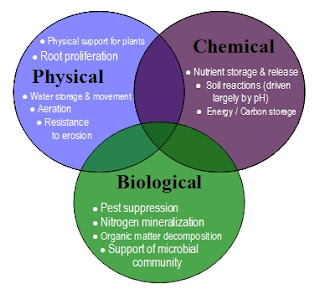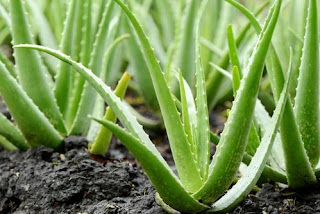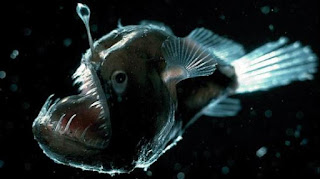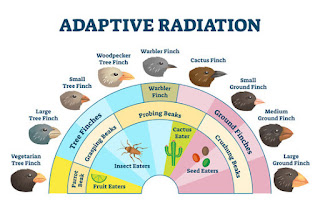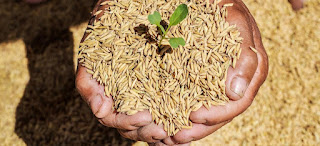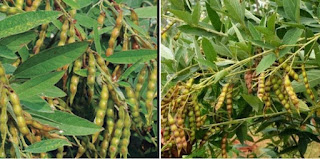Soil Pollution
Our living Planet, consists of
Atmosphere, Earth and Water. The
interaction of the Atmosphere,
Lithosphere, Hydrosphere and Biosphere
is continuing for years together. It was
clean and enjoyable. But due to the various
activities of man, the composition and
complex nature of environment got
changed. The activities include
industrialization, construction,
transportation, agriculture and
deforestation etc.., Such activities are
though desirable for human development
and welfare release unwanted materials into
the environment causing it to be imbalanced
rendering our life miserable.
What is soil?
Air, water and soil are three major
natural resources, alongside soil is one of
the marvellous products of nature without
which there would be no life. It is a natural
medium for plants to grow.
Soil is made up of minerals and
decomposed organic matter, along with air
and water. Soil is a habitat for many
organisms like, bacteria etc.., which in turn
feed and support plant life.
Healthy soil means the soil which
produces healthy plants, on eating which
animals also remain healthy.
How is soil formed?
Soil formation is a long and complex
process and it can take 100 to 10,000 years
to create one inch of top soil! It is driven
by many factors such as Climate,
Topography, living organisms and the type
of parent material. Parent materials come
from break down of underlying rocks or
from deposits by streams and rivers, seas
and gulfs, hills, wind and glaciers or organic
plant residues.
Over time, these materials are
weathered by the effects of freezing,
thawing, wetting, drying, heating, cooling,
erosion, plants, animals and from chemical
reactions. Eventually the parent material is
divided into three horizontal layers, the top
layer consists of mostly organic matter and
biological activity, the middle layer is the
zone of maximum material accumulation
and the bottom layer is mainly the parent
material.
The top soil is important since it is the
foundation for the life on the earth.
Soil properties:
Crop quality directly depends on
the quality of the agricultural soil in which
it is grown. The higher the quality of the
soil, the higher the quality of the crop
produced. To improve how to obtain high
quality soil, we must first understand the
fundamental properties of soil. These can
be divided into three major categories
physical, chemical and biological
properties.
Physical properties of soil:
Soil comprises of minerals, organic
matter, water and air. The composition and
proportion of these components greatly
influences physical properties of soil
including colour texture, structure and
porosity. These properties regulate and
affect air and water movement in the soil
and thus, soil ability to function. Organic
matter is the organic component of soil
which includes the dead and decaying
plants, animals and residues of organisms.
It consists of nutrients necessary for
plants growth such as Nitrogen, Phosphorus
and Potassium. Soils which contain 30%
or more organic matter are considered
organic soil; all other soils are identified
as mineral soils. Organic matter in soil
improves water infiltration, decreases
evaporation, and increases the water
holding capacity. Also, where there is
organic matter, there will be numerous
organisms present helping to convert it
back to nutrients and these organisms help
to create crumb, ideal for cultivation. Thus
balancing a natural state of soil.
Chemical properties of soil:
The term pH is used to indicate the level
of acidity or alkalinity of a soil. The range
of pH values of a good soil lies from 5.5
to 7.5. Below pH 7 the soils are termed as
acidic and above pH 7 alkaline.
The pH of soil is important to know the
type of vegetation that grows in the soil and
the type of organisms that live there. Also,
presence of organic matter in soil has a
close relationship with soil pH. Soil richer
in organic matter is acidic in nature as a
result of degradation of various substances
that produces various acids in soil.
Availability of plants nutrients depends on
the pH of soil.
Biological properties of Soil:
Soil is not a dead mass but an abode of
millions of organisms. It is the most
abundant and diverse ecosystem on the
earth. Soil organisms include both plants
and animal forms ranging from sub
microscopic Viruses to Earthworms, to
large burrowing animals such as Gophers
and ground Squirrels. Major microbial
groups in soil are bacteria, fungi, algae and
protozoa. These feed on plant residues
burrow the soil and help in aeration and
percolation of water.
This is the basis of nutrient cycles in all major ecosystems of the world. Besides their role in controlling the rates of production of inorganic forms from various organic forms, soil microbes, particularly, soil bacteria also control the forms of ions in which these nutrients occurs. We shall study this in detail in the chapter of ‘Biogeochemical cycles’.
SOIL FERTILITY:
How can you say that soil is fertile one. Discuss with your classmate write your opinion.
Fertility of soil depends on the properties of soil and is defined by its capacity to hold
water and nutrients and supply them to plants when they need them, independent of direct
application of nutrients. Transfer of nutrients from the soil’s organic matter to the mineral
stage strongly depends on the soil organisms’ activity and diversity. Soil organisms also
contribute to buildup soil organic matter, including Humus, the soil’s most important nutrient reservoir.
Proper soil fertility management is
very important for successful crop
production and farming. Organic farmers
regulate soil fertility by protecting the soil
and feeding it organic material, thus
ensuring quality yield. When the soil is
fertile in the organic sense, it can produce
good crop yields for several years. You
learned about organic farming in the
chapter 'Challenges in improving
agriculture.
Soil Pollution:
As we discussed above, soil serves as
the interface between Earth, Air and Water;
fulfilling a variety of complex,
interdependent functions essential to life.
Yet human activities alter its ability to
perform its job. As compared to the other
resources, it has taken a long time to
become aware of the wealth, complexity,
usefulness and fragility of the Soil. When
the quality of Air and Water deteriorates,
the threat to public health is felt
immediately. But as long as we can walk
on the earth under our feet, where’s the
danger?
The impacts of various human
activities for development and welfare are
invisible and land pollution is a good
example of that. We can’t easily see the
poisons that seep from underground
Mines, the Garbage we have dip into
landfills or from Industrialization,
Agriculture and other mismanagement by
human being. Land pollution, in short, is a
much bigger and more subtle problem than
it might appear. How does it occur? And
what can we do about it? These are the
questions to think about. But first let us
understand up to what extent we are as
human being, responsible for producing this
waste.
Let us read the following conversation
and prepare the list as per the instructions.
During interval time Venu was eating a
fruit. He was about to throw the peel in
corner of the varandah. His friend Ramu
stopped him. Ramu said you should not
throw waste in the varandah. Drop it in the
bin / basket.
Now let us think, what will happen if
you throw the wastes where ever you want?
Prepare a list of waste materials we
throw out in a day from morning to evening
classifying them as wet wastes and dry
wastes with the help of the example given
in the table below.
Activity-1:
Dumping and decomposing
We are producing tonns of wastes in
our daily activities. It is dumped at
wherever the vacant place is available in
Urban as well as Rural areas. Some of these
Can you imagine the quantity of waste
we produce in a day and what happens to
the waste materials we throw or dispose?
Activity-2:
Take a polythene bag/plastic bucket /
or any container. Fill half of it with soil.
Keep wet waste and other wastes in it.
(Waste should include vegetable peels,
rubber, plastic etc). Add some more soil
and sprinkle water regularly on it. Till it and
observe in 15 days intervals.
The waste generated from various
sources can be categorized into two types:
i) Biodegradable waste includes
substances that can be degraded by
microbes into harmless and non-toxic
substances.Agricultural and animal wastes
like leaves, twigs, hay, dung, etc. are
biodegradable wastes
Decomposition is the process of
degradation of materials into simpler
substances turning them into nutrients and
making available to plants.Thus, biodegradable materials contribute directly to
the fertility of the soil. However when there
is an excess of bio-degradable material, it
contributes the imbalance in the nature with
negative impact. On the other hand, nonbiodegradable materials directly contribute
to land pollution due to the excessive
amount and improper waste management.
Thus, soil or land pollution can be
understood as addition of substances which
adversely affect the quality of soil or its
fertility. Farmers use cow dung every year
in the fields. Polluted water also polluts
soil. Solid waste is a mixture of plastics,
cloth, glass, metal, organic matter, sewage,
sewage sludge, building debris, generated
from households etc.., commercial and
industrial establishments add to Soil
Pollution. Fly ash, iron and steel slag,
medical and industrial wastes disposed on
land are important sources of soil pollution.
In addition, fertilizers and pesticides from
agricultural use which reach soil as run-off
as well as land filling by municipal
waste are growing causes of soil pollution.
Acid rain and dry deposition of pollutants
on land surface also contribute to soil
pollution.
ii) Non-biodegradable waste cannot be
easily degraded. Aluminium cans, plastics,
glass, chemicals like DDT, etc. are
examples of non-biodegradable wastes.
Radioactive wastes produced during
nuclear reactions take a long time to decay
and are harmful to human beings. Now -adays 'e-waste' (computers, mobile waste)
also leads to soil pollution.
Causes of land pollution:
There are many different ways by which
land pollution can occur. Soils are
commonly used as dumps for household
and industrial wastes. In many intensively
farmed areas, leaching of nutrients from
manure or inorganic fertilizers and
effluents from processing plants may lead
to high level of nitrate and other chemicals
in ground water. Due to atmospheric
deposition (air pollution) soil gets
contaminated significantly. soil pollution
can be classified into the following
categories based on sources:
Agricultural Soil Pollution
Soil pollution by industrial
effluents and solid wastes
Pollution due to urban activities
Soil pollution is caused by the
presence of man-made chemicals or other
alteration in the natural soil environment.
This type of contamination typically arises
from the rupture of underground storage
links, application of pesticides, and
percolation of contaminated surface water
to subsurface strata, oil and fuel dumping.
Biomagnification:
The nutrients necessary for plant growth
(e.g., Nitrogen and Phosphorus) are found
at very low concentrations in most natural
waters. In order to obtain sufficient
quantities for growth, Phytoplankton must
collect these chemical elements from a
relatively large volume of water.
In the process of collecting nutrients,
phytoplankton also collects certain humanmade chemicals, such as some persistent pesticides.
Bio magnification
Deforestation:
Soil Erosion occurs when the
weathered soil particles are dislodged and
carried away by wind or water.
Deforestation, agricultural land
development, temperature extremes,
precipitation including acid rain, and human
activities contribute to this erosion.
Humans speed up this process by
construction, mining, cutting of timber,
over cropping and overgrazing. It results in
floods and soil erosion.
Forests and grasslands are an excellent
binding material that keeps the soil intact
and healthy. They support many habitats and
ecosystems, which provide innumerable
feeding pathways or food chains to all
species. Their loss would threaten food
chains and the survival of many species.
During the past few years quite a lot of vast
green land has been converted into deserts.
Deforestation is slowly destroying the most
productive flora and fauna areas in the
world, which also form vast tracts of a very
valuable sink for Co2.
Deforestation
Pollution due to urbanization:
Pollution of surface soils
Urban activities generate large
quantities of city wastes including several
Biodegradable materials (like
vegetables, animal wastes, papers,
wooden pieces, carcasses, plant twigs,
leaves, cloth wastes as well as
sweepings) and many nonbiodegradable materials (such as plastic
bags, plastic bottles, plastic wastes,
glass bottles, glass pieces, stone /
cement pieces). On a rough estimate
Indian cities are producing solid city
wastes to the tune of 50,000 - 80,000
metric tonns every day. If left
uncollected and decomposed, they are a
cause of several problems such as:
Clogging of drains: Causing
serious drainage problems
including the burst / leakage of
drainage lines leading to health
problems.
Barrier to movement of water:
Solid wastes have seriously
damaged the normal movement of
water thus creating problem of
inundation, damage to foundation
of buildings as well as public health
hazards.
Foul smell: Generated by dumping
the wastes at a place.
Increased microbial activities:
Microbial decomposition of
organic wastes generate large
quantities of methane besides many
chemicals to pollute the soil and
water flowing on its surface
As solid wastes and hospital wastes
create many health problems: They
may have dangerous pathogen
besides dangerous medicines, injections.
Solid waste management:
The solid wastes which are accumulated
on the soil will pose a great problem to us.
Throwing the wastes in dump yards is not
the solution to the problem. For throwing
wastes we need enormous land area.
For example in the state of Telangana
32 towns are there The average per capita solid wastes
produced per day is 364 grams. To dispose
all the wastes we need an area equal to the
size of Hyderabad city(590 sq km) by the
year 2021.
Thus, Proper methods should be
adopted for management of solid waste
disposal. Solid waste management involves
activities including collection, transfer and
transport to suitable sites, and safe disposal
of wastes by methods which are
environmentally compatible.
Industrial wastes can be treated
physically, chemically and biologically
until they are less hazardous. Acidic and
alkaline wastes should be first neutralized;
the insoluble material if biodegradable
should be allowed to degrade under
controlled conditions before being
disposed.


